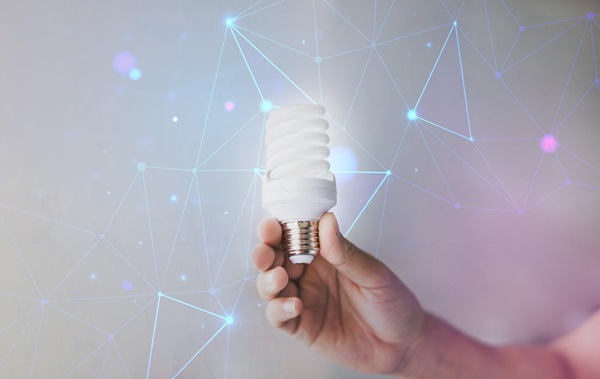I. Introduction
In today’s world, energy efficiency has become an increasingly critical focus for both individuals and organizations. With rising energy costs, growing environmental concerns, and the global push towards sustainability, energy-efficient technology is transforming how we live and do business. These innovations are designed to reduce energy consumption, lower carbon footprints, and ultimately contribute to a healthier planet. The impact of energy-efficient technology on homes and businesses is significant, driving cost savings, enhancing comfort, and improving overall operational efficiency.

This article explores the growing importance of energy-efficient technology, delving into its benefits for both residential and commercial applications. From smart thermostats and energy-efficient lighting in homes to advanced HVAC systems and building management technologies in businesses, we will examine how these advancements are reshaping our approach to energy use. Additionally, we will look at real-world case studies, discuss the challenges and considerations in adopting these technologies, and explore the future trends that will further revolutionize the energy landscape.
II. Understanding Energy Efficiency
Energy efficiency refers to the ability to achieve the same level of energy service or output while using less energy. It involves utilizing technologies, systems, and practices that reduce energy waste, optimize energy consumption, and improve overall performance. The key principles of energy efficiency include reducing unnecessary energy use, maximizing the efficiency of energy conversion, and minimizing energy loss.
Energy-efficient technology offers substantial benefits, primarily through cost savings and environmental impact reduction. For instance, using less energy to power homes and businesses translates to lower energy bills and reduced strain on energy grids. Additionally, energy-efficient practices and technologies significantly reduce greenhouse gas emissions, contributing to global efforts to combat climate change. Whether through cutting-edge appliances, smart home systems, or large-scale renewable energy integration, energy efficiency is a pivotal component of the sustainable future.
III. Energy-Efficient Technologies for Homes
a. Smart Thermostats
One of the most impactful energy-efficient technologies available for homes today is the smart thermostat. Smart thermostats, such as Nest and Ecobee, use sensors, Wi-Fi connectivity, and machine learning algorithms to optimize heating and cooling in a home. These devices learn a household’s temperature preferences and automatically adjust settings to ensure comfort while conserving energy.
The benefits of smart thermostats extend beyond simple temperature control. They offer significant cost savings by optimizing HVAC systems to run only when necessary, reducing energy waste. Additionally, these devices provide convenience through remote access, allowing homeowners to adjust settings from their smartphones or integrate them with voice-activated assistants like Amazon Alexa or Google Assistant. Overall, smart thermostats exemplify how energy-efficient technology enhances both sustainability and convenience in modern homes.
b. Energy-Efficient Lighting
Lighting accounts for a significant portion of residential energy consumption, making energy-efficient lighting solutions a key component of energy-saving strategies. Traditional incandescent bulbs are highly inefficient, converting only a small percentage of electricity into visible light while wasting the rest as heat. In contrast, LED (light-emitting diode) bulbs are far more energy-efficient, converting most of the energy into light and lasting much longer than traditional bulbs.
Energy-efficient technology in lighting, such as LED bulbs, not only reduces energy consumption but also offers increased longevity, resulting in fewer replacements and lower maintenance costs. Examples like Philips Hue and LIFX smart lighting systems further enhance energy efficiency by offering customizable lighting schedules and brightness adjustments, all controlled through smartphone apps or voice commands. By upgrading to energy-efficient lighting, homeowners can drastically reduce their energy bills while enjoying the benefits of modern smart home innovations.
c. High-Efficiency Appliances
High-efficiency appliances are a cornerstone of energy-efficient homes. These appliances, which include refrigerators, washing machines, and dishwashers, are designed to consume less energy while maintaining high performance. Energy Star-rated appliances, for example, meet rigorous energy efficiency guidelines set by the U.S. Environmental Protection Agency (EPA) and the Department of Energy (DOE).
The benefits of energy-efficient technology in appliances are clear: reduced energy consumption leads to lower utility bills and less environmental impact. Whether it’s a refrigerator that uses advanced insulation and compressor technology or a washing machine that conserves water and electricity, high-efficiency appliances make a substantial difference in household energy use. By investing in these technologies, homeowners not only save money but also contribute to global sustainability efforts.
d. Home Insulation and Windows
Proper insulation and high-quality windows play a crucial role in maintaining a home’s energy efficiency. Homes that are not adequately insulated or have inefficient windows experience significant heat loss in the winter and heat gain in the summer, leading to increased energy consumption for heating and cooling.
Energy-efficient technology, such as triple-pane windows and spray foam insulation, addresses this issue by improving a home’s thermal envelope. Triple-pane windows offer superior insulation by trapping air between layers of glass, preventing heat transfer. Similarly, spray foam insulation expands to fill gaps and cracks, creating a tight seal that minimizes energy loss. By upgrading to energy-efficient insulation and windows, homeowners can reduce their reliance on HVAC systems and enjoy lower energy costs year-round.
IV. Energy-Efficient Technologies for Businesses
1. Building Management Systems (BMS)
For businesses, energy-efficient technology is crucial for reducing operational costs and improving sustainability. Building management systems (BMS) are advanced platforms that monitor and control a building’s electrical, mechanical, and HVAC systems. These systems use sensors, automation, and data analytics to optimize energy use, ensuring that energy is only consumed when needed.
Companies like Honeywell and Johnson Controls offer BMS solutions that allow businesses to track energy consumption in real time, adjust settings remotely, and identify areas for improvement. The benefits of BMS include significant cost savings, improved building performance, and enhanced comfort for occupants. As energy-efficient technology continues to evolve, BMS will become increasingly integrated with renewable energy sources, further reducing a building’s carbon footprint.
2. Energy-Efficient HVAC Systems
Heating, ventilation, and air conditioning (HVAC) systems are some of the largest energy consumers in commercial buildings. Energy-efficient HVAC systems, such as variable refrigerant flow (VRF) systems and high-efficiency furnaces, allow businesses to regulate temperature more efficiently while using less energy.
VRF systems, for instance, allow for precise temperature control in different zones of a building, reducing the need to heat or cool unoccupied spaces. High-efficiency furnaces, on the other hand, use advanced combustion technologies to achieve greater fuel efficiency. These systems not only reduce energy consumption but also improve air quality, making them a critical component of energy-efficient technology in business environments.
3. Renewable Energy Integration
Renewable energy integration is another key area where energy-efficient technology makes a difference for businesses. By installing solar panels or wind turbines, companies can generate their clean energy, reducing reliance on traditional power grids and lowering energy costs.
Companies like Tesla Solar and GE Wind Turbines offer scalable renewable energy solutions that can be customized to meet the needs of businesses of all sizes. The benefits of renewable energy integration include energy independence, long-term cost savings, and a reduced environmental impact. As renewable technologies continue to advance, more businesses are expected to adopt these energy-efficient technologies to meet their sustainability goals.
4. Energy-Efficient Lighting Solutions
Similar to residential applications, energy-efficient lighting solutions are essential for businesses looking to reduce their energy consumption. Commercial LED lighting, offered by companies like Cree and Osram, provides businesses with a cost-effective way to illuminate large spaces while using a fraction of the energy required by traditional lighting.
Energy-efficient technology in commercial lighting not only reduces energy consumption but also lowers maintenance costs due to the longer lifespan of LED bulbs. Additionally, many commercial lighting systems offer smart controls, allowing businesses to adjust lighting levels based on occupancy or time of day, further enhancing energy efficiency.
V. Case Studies
Residential Example: In one residential retrofit project, a homeowner replaced outdated insulation, windows, and lighting with energy-efficient alternatives. The project also included the installation of a smart thermostat and high-efficiency appliances. As a result, the homeowner saw a 30% reduction in energy bills and improved comfort throughout the home. This case study highlights the transformative power of energy-efficient technology in residential settings.
Commercial Example: A medium-sized business implemented energy-efficient technology by upgrading to a building management system, energy-efficient HVAC units, and solar panels. Within two years, the company achieved a 25% reduction in energy consumption and a significant decrease in operating costs. This example illustrates how businesses can benefit from adopting energy-efficient technologies while contributing to a more sustainable future.
VI. Challenges and Considerations
While the benefits of energy-efficient technology are clear, there are challenges and considerations that must be addressed. One of the primary challenges is the initial cost of adopting energy-efficient technologies, which can be high for both homeowners and businesses. However, these upfront costs are often offset by long-term savings on energy bills.
Additionally, technological advancements are continuously evolving, which can make it challenging to determine the best solutions to invest in. It is important for consumers and businesses to stay informed about the latest energy-efficient technologies to ensure they are making the most cost-effective and sustainable choices. Maintenance and operational considerations also play a role, as energy-efficient systems often require specialized care and expertise.
VII. Future Trends in Energy Efficiency
The future of energy-efficient technology is promising, with several emerging trends poised to transform how we consume and manage energy. Smart grids, for instance, are being developed to optimize energy distribution, allowing for more efficient use of renewable energy sources and reducing energy waste across entire cities.
Advanced energy storage solutions, such as next-generation batteries, are also on the horizon. These technologies will allow homes and businesses to store excess energy generated from renewable sources, ensuring a steady supply even when the sun isn’t shining or the wind isn’t blowing.
Additionally, artificial intelligence (AI) and machine learning are expected to play a growing role in optimizing energy use. AI-driven systems can analyze vast amounts of data to predict energy demand and adjust consumption patterns accordingly. This integration of AI with energy-efficient technology will enable even greater efficiency gains in the years.
VIII. Conclusion
Energy-efficient technology is rapidly transforming the way we live and do business, offering tangible benefits in terms of cost savings, environmental impact, and overall efficiency. Whether through smart thermostats in homes, building management systems in businesses, or the integration of renewable energy sources, these technologies are paving the way for a more sustainable future. As energy demands continue to rise globally, adopting energy-efficient technology is not just an option—it’s a necessity.
The importance of investing in energy-efficient technologies cannot be overstated. Homeowners and businesses alike must consider the long-term advantages of these innovations, from reduced energy bills to improved comfort and sustainability. While challenges such as initial costs and technological advancements may exist, the long-term benefits far outweigh the hurdles.
As we move forward, staying informed about the latest trends in energy efficiency will be crucial for maximizing the benefits of these technologies. Whether you’re upgrading your home or transforming your business, energy-efficient technology offers a clear path to a greener, more cost-effective future. Now is the time to embrace these advancements and take steps toward a more energy-efficient world.

